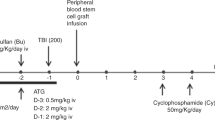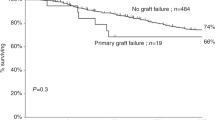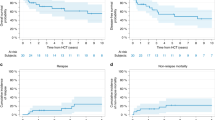Abstract
Summary:
Graft-versus-host disease (GVHD) remains a major barrier to successful hematopoietic stem cell transplant for patients who lack a matched related donor. Partial T-cell depletion (TCD) of the graft may decrease the risk of severe GVHD with unrelated donors (URD) and partially matched related donors (PMRD) while retaining an antileukemic effect. We analyzed our experience using URD and PMRD for pediatric patients with leukemias from 1990 to 2001. A subgroup of ‘matched’ URD donor pairs was retrospectively analyzed for high-resolution class I. Partial TCD was accomplished with monoclonal antibody T10B9 or OKT3 and complement. There were 76 URD (45% matched) and 28 PMRD recipients. Event-free survival (EFS) was 38.3%, and overall survival (OS) 45.1% at 3 years. On multivariate analysis, there was no difference in survival based upon marrow source, but nonrelapse mortality was higher with the use of PMRD. Relapse occurred in 6% of ALL patients, and 22.8% of AML/MDS patients. Grades III–IV GVHD was observed in only 6.7% of patients. Partial TCD allows use of matched or mismatched URD, or PMRD with little mortality from GVHD, durable engraftment, and no increase in relapse risk.
This is a preview of subscription content, access via your institution
Access options
Subscribe to this journal
Receive 12 print issues and online access
$259.00 per year
only $21.58 per issue
Buy this article
- Purchase on Springer Link
- Instant access to full article PDF
Prices may be subject to local taxes which are calculated during checkout


Similar content being viewed by others
References
Balduzzi A, Gooley T, Anasetti C et al. Unrelated donor marrow transplantation in children. Blood 1995; 86: 3247–3256.
Davies S, Ramsay N, Haake R et al. Comparison of engraftment in recipients of matched sibling or unrelated donor marrow allografts. Bone Marrow Transplant 1994; 13: 51–57.
Vettenranta K, Saarinen-Pihkala U, Cornish J et al. Pediatric marrow transplantation for acute leukemia using unrelated donors and T-replete or -depleted grafts: a case matched analysis. Bone Marrow Transplant 2000; 25: 395–399.
Green A, Clarke EHL, Hunt L et al. Children with acute lymphoblastic leukemia who received T-cell-depleted HLA mismatched marrow allografts from unrelated donors have an increased incidence of primary graft failure but a similar overall transplant outcome. Blood 1999; 94: 2236–2246.
Kernan N, Bordignon C, Heller G et al. Graft failure after T-cell-depleted human leukocyte antigen identical marrow transplants for leukemia: I. Analysis of risk factors and results of secondary transplants. Blood 1989; 74: 2227–2236.
Hopkins K . The basic lymphocyte microcytoxicity tests: standard and AHG enhancement. In: Amy K, Geoffrey L, Rosemarie S (eds). ASHI Laboratory Manual, 4th edn. American Society for Histocompatibility and Immunogenetics, 2000, pp 1–7.
Ballas M, Oechsle T, Eiermann C et al. A DRB oligonucleotide typing system defining 50 of 56 DRB alleles. In: Tsuji K, Aizawa M, Sasazuki T (eds). Proceedings of the Eleventh International Histocompatibility Workshop and Conference. Oxford University Press: New York, 1992, p 311.
Hurley C, Maiers M, Ng J et al. Large-scale DNA-based typing of HLA-A and HLA-B at low resolution is highly accurate, specific and reliable. Tissue Antigens 2000; 55: 352–358.
Casper J, Camitta B, Truitt R et al. Unrelated bone marrow donor transplants for children with leukemia or myelodysplasia. Blood 1995; 85: 2354–2364.
Glucksberg H, Storb R, Fefer A et al. Clinical manifestations of graft-versus-host disease in human recipients of marrow from HLA-matched sibling donors. Transplantation 1974; 18: 295–304.
Storb R, Prentice R, Sullivan K et al. Predictive factors in chronic graft-versus-host disease in patients with aplastic anemia treated by bone marrow transplantation from HLA-identical siblings. Ann Int Med 1983; 98: 461–466.
Bunin N, Carston M, Wall D et al. Unrelated marrow transplantation for children with acute lymphoblastic leukemia in second remission. Blood 2002; 99: 3151–3157.
Godder K, Pati A, Abhyankar S et al. De novo chronic graft-versus-host disease presenting as hemolytic anemia following partially mismatched related donor bone marrow transplant. Bone Marrow Transplant 1997; 19: 813–817.
Davies S, Wagner J, Shu X et al. Unrelated donor bone marrow transplantation for children with acute leukemia. J Clin Oncol 1997; 15: 557–565.
Woolfrey A, Anasetti C, Storer B et al. Factors associated with outcome after unrelated marrow transplantation for treatment of acute lymphoblastic leukemia. Blood 2002; 99: 2002–2008.
Champlin R, Passweg J, Zhang M et al. T-cell depletion of bone marrow transplants for leukemia from donors other than HLA-identical siblings: advantage of T-cell antibodies with narrow specificities. Blood 2000; 95: 3996–4000.
Ash R, Casper J, Chitambar C et al. Successful allogeneic transplantation of T-cell-depleted bone marrow from closely HLA-matched unrelated donors. N Engl J Med 1990; 322: 485–494.
Keever-Taylor C, Craig A, Molter M et al. Complement-mediated T-cell depletion of bone marrow: comparison on T10B9.1A-31 and Muromonab-Orthoclone OKT3. Cytotherapy 2001; 3: 467–481.
Prasad V, Kernan N, Heller G et al. DNA typing for HLA-A and HLA-B identified disparities between patients and unrelated donors matched by HLA-A and HLA-B serology and HLA-DRB1. Blood 1999; 93: 399–409.
Petersdorf E, Hansen J, Martin P et al. Major-histocompatibility-complex class I alleles and antigens in hematopoietic-cell transplantation. N Engl J Med 2001; 345: 1794–1800.
Giebel S, Giogiani G, Marinetti M et al. Low incidence of severe acute graft-versus-host disease in children given hematopoietic stem cell transplantation from unrelated donors prospectively matched for HLA class I and II alleles with high-resolution molecular typing. Bone Marrow Transplant 2003; 31: 987–993.
Davies S, Shu X, Blazar B et al. Unrelated donor bone marrow transplantation: influence of HLA A and B incompatibility on outcome. Blood 1995; 86: 1636–1642.
Petersdorf E, Longton G, Anasetti C et al. Association of HLA-C disparity with graft failure after marrow transplantation from unrelated donors. Blood 1997; 89: 1818–1823.
Johnston R, Geretti A, Grant P et al. HHB-6-related secondary graft failure following allogeneic bone marrow transplantation. Br J Haematol 1999; 105: 1041–1043.
Cohen A, Luger S, Sickles C et al. Gemtuzumab ozogamicin (Mylotarg) monotherapy for relapsed AML after hematopoietic stem cell transplant: efficacy and incidence of hepatic veno-occlusive disease. Bone Marrow Transplant 2002; 30: 23–28.
Broun E, Tricot G, Akard L et al. Treatment of refractory lymphoma with high dose cytarabine, cyclophosphamide and either TBI or VP-16 followed by autologous bone marrow transplantation. Bone Marrow Transplant 1990; 5: 341–344.
Mehta J, Singhal S, Gee A et al. Bone marrow transplantation from partially HLA-mismatched family donors for acute leukemia: a single-center experience of 201 patients. Bone Marrow Transplant 2004; 33: 389–396.
Godder K, Hazlett L, Abhyankar S et al. Partially mismatched related-donor bone marrow transplantation for pediatric patients with acute leukemia: younger donors and absence of peripheral blasts improve outcome. J Clin Oncol 2000; 18: 1856–1866.
Drobyski W, Klein J, Flomenberg N et al. Superior survival associated with transplantation of matched unrelated versus one-antigen-mismatched unrelated or highly human leukocyte antigen-disparate haploidentical family donor marrow grafts for the treatment of hematologic malignancies: establishing a treatment algorithm for recipients of alternative donor grafts. Blood 2002; 99: 806–814.
Handgretinger R, Klingebiel T, Lang P et al. Megadose transplantation of purified peripheral blood CD34+ progenitor cells from HLA-mismatched parental donors in children. Bone Marrow Transplant 2001; 27: 777–783.
Locatelli F, Rocha V, Chastang C et al. Factors associated with outcome after cord blood transplantation in children with acute leukemia. Blood 1999; 93: 3662–3671.
Author information
Authors and Affiliations
Corresponding author
Rights and permissions
About this article
Cite this article
Bunin, N., Aplenc, R., Leahey, A. et al. Outcomes of transplantation with partial T-cell depletion of matched or mismatched unrelated or partially matched related donor bone marrow in children and adolescents with leukemias. Bone Marrow Transplant 35, 151–158 (2005). https://doi.org/10.1038/sj.bmt.1704754
Received:
Accepted:
Published:
Issue Date:
DOI: https://doi.org/10.1038/sj.bmt.1704754
Keywords
This article is cited by
-
High-dose corticosteroids with or without etanercept for the treatment of idiopathic pneumonia syndrome after allo-SCT
Bone Marrow Transplantation (2012)
-
Unrelated donor or partially matched related donor peripheral stem cell transplant with CD34+ selection and CD3+ addback for pediatric patients with leukemias
Bone Marrow Transplantation (2006)



